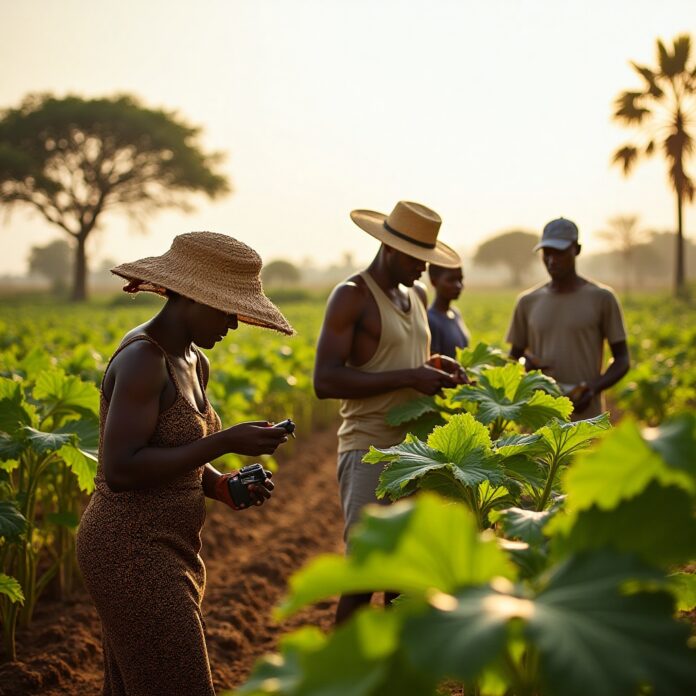Cassava isn’t just a crop—it’s a lifeline. Drought-resistant and versatile, it feeds millions and fuels economies, especially in regions like West Africa. But between pests, post-harvest losses, and market swings, farming cassava isn’t for the faint-hearted. Let’s break down how to grow, process, and profit from cassava, with lessons from farmers who’ve turned struggles into success.
🏗️ BuildNaija Expo 2025!
🗓️ May 30-31 | Online Event via Google Meet
Cassava Farming Essentials – Soil, Planting, and Pest Control
Cassava thrives in well-drained, sandy-loam soils—its “comfort zone.” Waterlogged soil? That’s a root rot invitation. Farmers in Nigeria and Ghana often intercrop with legumes like cowpeas, which repel pests like whiteflies and boost soil nitrogen naturally.
Planting smart starts with disease-free stem cuttings. Varieties like TME 419 or Pro-Vit A resist mosaic virus (CMD) and yield chunky roots. Sterilize tools with hot water—it’s like handwashing for cassava.
Pests? Meet nature’s hitmen. Cassava mealybugs drain leaves, but Anagyrus lopezi wasps parasitize them. Nigerian farmers swear by these “bio-warriors.” For green mites, neem oil or predatory mites act as plant bodyguards.
Garri Processing – Fermentation, Drying, and Quality Control
Turning roots into garri? Start with peeling and washing. Mechanized peelers (like Henan Jinrui’s) reduce toxin risks. Ferment mash for 2–4 days—too short, cyanide lingers; too long, it sours. Ghanaian farmers use weighted sacks to press out water, blending tradition with efficiency.
🏗️ BuildNaija Expo 2025!
🗓️ May 30-31 | Online Event via Google Meet
Drying is make-or-break. Sun-drying is free but risky—rain invites mold. Mechanical dryers (80–100°C) guarantee consistency. Quality garri glows pale gold, sieved to 10–12% moisture. Too damp? Fungi party. Too dry? It crumbles.
Pricing Strategies – Turning Garri into Profit, Not Just Powder
Garri prices swing with seasons. In Lagos, premium Ijebu garri hits ₦1,500/kg, while cheaper variants hover at ₦800. Sell during Ramadan or Christmas for 20–30% markups. One Benin City farmer stockpiles in airtight drums, releasing stock strategically.
Cut costs creatively. Cooperatives in Imo State bulk-buy sacks, slashing packaging costs by 40%. Apps like Trade Lenda connect farmers directly to buyers—no middlemen skimming profits.
🏗️ BuildNaija Expo 2025!
🗓️ May 30-31 | Online Event via Google Meet
Value addition = premium prices. Fortify garri with moringa or soy flour. An Accra entrepreneur packages hers in QR-coded pouches, linking to nutrition facts—urban moms pay double.
Regional Success Stories – Lessons from the Field
- Oyo State, Nigeria: Adeola’s marigold-intercropped fields repel nematodes; pheromone traps catch moths. Her 60% yield boost supplies Lagos supermarkets.
- Ashanti Region, Ghana: Kojo’s bamboo solar dryer slashes drying time to 8 hours. A $5 hygrometer ensures EU-standard garri, sold for euros.
- Kara, Togo: A women’s coop uses biogas presses, cutting costs and deforestation. Their “Garri that saves trees” earns a 15% green premium in France.
Tools & Resources – Your Cassava Farming Toolkit
- Government support: Nigeria’s Anchor Borrowers Programme offers low-interest loans; Ghana’s Planting for Food and Jobs subsidizes cuttings.
- Tech hacks: Apps like FarmCrowdy (Nigeria) or AgriApp (Ghana) track prices and crowdfund gear. One Enugu farmer nabbed a solar dryer in 48 hours via FarmCrowdy.
- Extension officers: Kenya’s iCow sends pest alerts via SMS. Your local agri-office? Think of them as farming Google.
From Roots to Resilience
Cassava’s power lies in blending tradition with innovation. Test one new method each season—pheromone traps, solar dryers, fortified garri. Share wins (and fails) with your cooperative. When pests or prices bite, remember Adeola, Kojo, or Togo’s biogas pioneers. Adapt, don’t quit.
FAQs – Your Burning Questions, Answered
- “Cassava mosaic virus signs?” Yellow, patchwork leaves. Uproot infected plants; switch to TME 419.
- “Testing garri moisture?” Squeeze it—clumps mean damp. Use the “nail and bag” trick for precision.
- “Storing garri?” Airtight containers + dried chili peppers = 6–12 months shelf life.
- “Spotting fake pesticides?” Check registration numbers, expiry dates, tamper-proof seals.
- “WhatsApp for prices?” Join groups like Garri Sellers Network NG—voice notes reveal buyer urgency.
- “Fast peeling?” Soak roots first or use a $5 curved peeler for 100kg/hour efficiency.
Final Note
Cassava isn’t just a root—it’s roots for change. Share this guide. Tag that friend drying garri on bare soil. And when you toast success with palm wine, remember: You’ve got this.
🏗️ BuildNaija Expo 2025!
🗓️ May 30-31 | Online Event via Google Meet
Drop your cassava hack below. Let’s grow this community.




